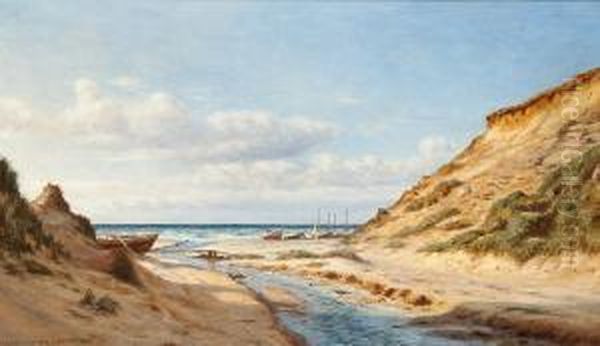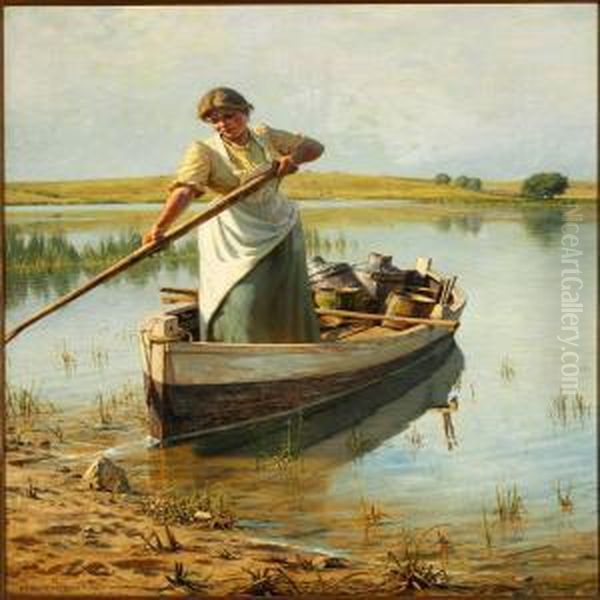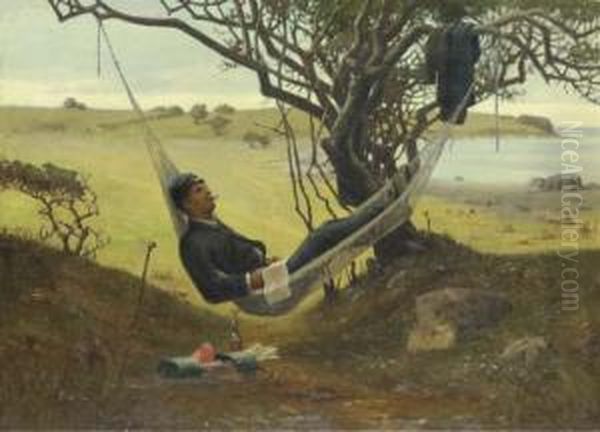
Niels Frederik Schiøttz-Jensen stands as a figure within the rich tapestry of Danish art during the late 19th and early 20th centuries. Born in Vordingborg, Denmark, in 1855, his life spanned a period of significant artistic evolution in Scandinavia and Europe. He passed away in Copenhagen in 1941, leaving behind a body of work primarily focused on oil painting, capturing the essence of Danish landscapes and the character of its people.
Though perhaps not as internationally renowned as some of his contemporaries, Schiøttz-Jensen contributed to the artistic dialogue of his time through his dedicated practice. His work reflects the prevailing interest in depicting the natural world and everyday life, themes that resonated deeply within Danish art circles during his active years. He established himself as both a landscape and portrait painter, navigating the currents of Naturalism, Realism, and the enduring legacy of Romanticism.
Artistic Focus: Landscapes and Portraits
Schiøttz-Jensen's artistic identity is strongly tied to his work as a landscape and portrait painter. The Danish landscape, particularly its coastal regions, appears to have held a special significance for him. His paintings often sought to capture the specific light, atmosphere, and topography of his homeland, aligning him with a strong national tradition of landscape painting that had flourished since the Danish Golden Age earlier in the 19th century, pioneered by figures like C.W. Eckersberg and Christen Købke.
His affinity for coastal scenes is specifically highlighted by his connection to Lønstrup, a location on the North Jutland coast known for its dramatic shoreline and fishing communities. This area also attracted other artists, drawn to its rugged beauty and the quality of its natural light. Schiøttz-Jensen's painting Lønstrup Beach, dated 1898, serves as an example of this focus. Such works suggest an artistic style potentially influenced by Naturalism or Realism, aiming for a faithful representation of the observed world, yet possibly imbued with a personal, perhaps Romantic, appreciation for the power and beauty of nature.

Beyond landscapes, Schiøttz-Jensen also engaged in portraiture. While the provided information doesn't detail specific sitters or the extent of his portrait work, this genre was a staple for many artists of the period, providing income and opportunities to study human character. His engagement with both landscape and portraiture places him firmly within the mainstream of Danish artistic practice of his era.
Notable Works: Capturing Danish Life
Two specific works offer glimpses into Schiøttz-Jensen's thematic interests and artistic output. Paa vej til malkepladsen (translated as 'Milkmaid on the way to the milking place' or similar) is an oil painting dated 1894. This work places him within the tradition of genre painting – scenes of everyday life, often featuring rural or working-class subjects. Such themes were popular, reflecting a broader European interest in depicting the lives of ordinary people, a trend seen in the work of French Realists like Jean-François Millet, but adapted to a Danish context by artists like L.A. Ring.
The fact that Paa vej til malkepladsen was exhibited at Charlottenborg is significant. The Charlottenborg Spring Exhibition in Copenhagen was, and remains, a major venue for Danish artists to display their work and gain recognition. Its inclusion there suggests the painting met the contemporary standards of quality and interest. The subject matter – a milkmaid engaged in her daily task – speaks to a connection with rural life and traditional labour, common themes in Danish art that often carried connotations of national identity and pastoral virtue.
Another key work mentioned is An Afternoon's Rest, painted earlier in 1885. This piece appears to delve into social themes, focusing on the concept of rest within the context of work. The painting is described as touching upon workers' rights and the conditions surrounding breaks – lunch periods, negotiated time off, and even basic needs. This suggests a potential alignment with Social Realism, an artistic current that aimed to highlight the conditions and struggles of the working class.
The theme of An Afternoon's Rest is particularly interesting as it reflects societal discussions happening during the late 19th century regarding industrialization, labour laws, and the welfare of workers. By choosing this subject, Schiøttz-Jensen may have been engaging with contemporary social concerns, using his art not just for aesthetic representation but also as a subtle form of commentary. It showcases a depth beyond pure landscape, revealing an interest in the human condition within the framework of daily life and labour.
Travels and Artistic Connections

Artists of Schiøttz-Jensen's generation often travelled to broaden their horizons and engage with different artistic traditions. Italy, particularly Rome, remained a significant destination, continuing a tradition established during the Danish Golden Age. The provided information notes that Schiøttz-Jensen spent time living in Rome alongside another Danish artist, Christian Mølsted (1862-1930).
Christian Mølsted was primarily known as a marine painter, celebrated for his dramatic depictions of seascapes and historical naval battles. While their time together in Rome likely occurred in the late 19th or early 20th century (rather than the early 1800s, which seems chronologically inconsistent with their lifespans), the experience would have been formative. Rome offered exposure to classical antiquity, Renaissance and Baroque masterpieces, and a vibrant international community of artists.
Living and potentially working alongside Mølsted in Rome could have fostered artistic exchange, discussion, and mutual influence, even if their primary subjects differed. Such experiences abroad often refined an artist's technique, broadened their palette, or introduced new compositional ideas. The shared Danish background in a foreign setting might also have strengthened their connection to their national artistic identity while simultaneously exposing them to broader European trends. Schiøttz-Jensen's appreciation for the Lønstrup coast, a subject also favoured by marine and landscape painters, might resonate with Mølsted's own focus on coastal and maritime themes.
Context: Danish Art in a Time of Transition
Niels Frederik Schiøttz-Jensen worked during a dynamic period in Danish art history. The late 19th century saw the continuation of Realism and Naturalism, but also the emergence of Symbolism and early Modernist impulses. He was a contemporary of several major figures and movements that shaped the Danish art scene.
The Skagen Painters were arguably the most famous group during this era. Artists like P.S. Krøyer, Michael Ancher, and Anna Ancher gathered in the remote fishing village of Skagen at the northern tip of Jutland. They were known for their plein-air techniques, capturing the unique light of the region and depicting the lives of the local fishermen and the social life of the artists themselves. While Schiøttz-Jensen's connection was to Lønstrup further down the coast, the Skagen Painters' focus on coastal light and everyday life provides a relevant parallel.

Another significant contemporary was Vilhelm Hammershøi, known for his quiet, enigmatic interiors, cityscapes, and portraits, rendered in a muted palette. Though stylistically distinct from Schiøttz-Jensen's known work, Hammershøi represents another facet of the introspective and subtly modern trends in Danish art at the time. L.A. Ring, mentioned earlier, was a key figure in Danish Realism and Symbolism, focusing on the landscapes and people of rural Zealand, often imbuing his scenes with deeper symbolic meaning about life, death, and societal change.
The Funen Painters (Fynboerne), including artists like Peter Hansen, Fritz Syberg, and Johannes Larsen, emerged slightly later, around the turn of the century. They shared an interest in depicting everyday rural life and the landscapes of the island of Funen, often with a robust, earthy realism and a focus on family and community. Their work continued the Danish tradition of finding artistic inspiration in the local environment.
Other notable figures included Theodor Philipsen, who was influenced by French Impressionism and known for his depictions of animals and landscapes, bringing a brighter palette and looser brushwork to Danish painting. J.F. Willumsen represented a more radical break, embracing Symbolism and Expressionism with bold colours and dynamic forms. Placing Schiøttz-Jensen amidst these diverse contemporaries – Krøyer, the Anchers, Hammershøi, Ring, Hansen, Syberg, Larsen, Philipsen, Willumsen, and his associate Mølsted – highlights the varied artistic landscape he navigated.
Style Revisited: Realism, Nature, and Emotion
Based on the available descriptions, Schiøttz-Jensen's style appears to blend elements of Realism and Naturalism with a possible undercurrent of Romantic sensibility, particularly in his landscapes. The goal of Realism – to depict subjects truthfully, without artificiality or idealization – seems evident in works like An Afternoon's Rest with its focus on workers' conditions, and Paa vej til malkepladsen portraying a common rural task.
His landscape work, especially the focus on the Lønstrup coast, aligns with the Naturalist impulse to observe and record the natural world accurately. However, the description also mentions a potential "personal emotion" and "love of nature," suggesting that his depictions might go beyond mere objective recording. This hints at a lingering Romantic sensibility – an appreciation for the sublime or picturesque qualities of nature, and an emotional connection between the artist and the landscape. This blend was not uncommon in the late 19th century, as artists grappled with new ideas while still connected to older traditions.

The lack of information regarding specific influences makes it difficult to pinpoint direct artistic lineage beyond the general trends of Danish and European art of the period. He seems to have absorbed the prevailing interest in landscape, portraiture, and genre scenes, interpreting them through his own observational skills and perhaps a particular affinity for certain locations and themes. His work likely reflects the solid academic training expected of Danish artists, possibly at the Royal Danish Academy of Fine Arts in Copenhagen, emphasizing drawing, composition, and a faithful rendering of light and form.
Exhibitions and Recognition
The Charlottenborg exhibition of Paa vej til malkepladsen in 1894 confirms Schiøttz-Jensen's participation in the established Danish art world. The Charlottenborg exhibitions were crucial for artists seeking visibility and sales. However, the provided text explicitly states that information regarding other significant exhibitions or activities throughout his long career is lacking in the source material.
Similarly, there is no mention of any specific awards or honours bestowed upon Niels Frederik Schiøttz-Jensen for his artistic achievements. While other individuals with the surname Jensen (Jens Nielsen, Jens-Kjeld Jensen, Jacob Jensen) are mentioned as recipients of various awards in science, environment, and design respectively, this information is unrelated to the painter Niels Frederik Schiøttz-Jensen. The absence of such records in the provided text means his level of contemporary recognition through official accolades remains unclear.
Despite this lack of detail on formal recognition, his consistent work as an oil painter, his focus on core genres like landscape and portraiture, his engagement with specific Danish locations like Lønstrup, and his participation in venues like Charlottenborg indicate a dedicated professional career within the Danish art community of his time.
Legacy and Conclusion
Niels Frederik Schiøttz-Jensen emerges from the available information as a competent and engaged Danish artist of the late 19th and early 20th centuries. His work centred on the enduring themes of landscape, portraiture, and scenes of everyday life, reflecting the broader currents of European Realism and Naturalism adapted to a Danish context. His paintings, such as Paa vej til malkepladsen and An Afternoon's Rest, provide valuable insights into the artistic interests and potential social awareness of the period.
His connection to specific Danish locales like Lønstrup underscores the importance of place in Danish art, while his time spent in Rome with fellow artist Christian Mølsted points to the international dimension of artistic development for his generation. Although detailed information about his full exhibition history or any awards received is not provided, his documented works and participation in the Charlottenborg exhibition confirm his activity within the professional art scene.
Living from 1855 to 1941, Schiøttz-Jensen witnessed immense changes in the art world, from the dominance of Realism to the rise of Modernism. His own work appears rooted in the representational traditions prevalent during the main part of his career. He contributed to the rich visual record of Danish life and landscape, standing alongside contemporaries like the Skagen Painters, L.A. Ring, and Vilhelm Hammershøi, each offering their unique perspective on their time and place. Niels Frederik Schiøttz-Jensen remains a part of Denmark's artistic heritage, a painter dedicated to capturing the world around him through the medium of oil paint.